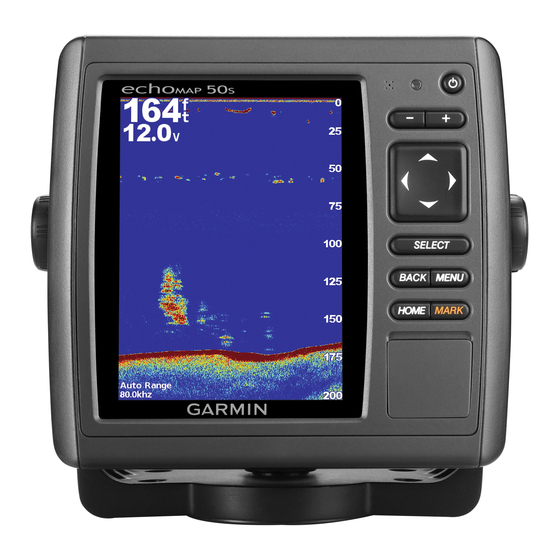Adjusting the Distance from Shore
The Auto Guidance feature is based on electronic chart
information. That data does not ensure obstacle and bottom
clearance. Carefully compare the course to all visual sightings,
and avoid any land, shallow water, or other obstacles that may
be in your path.
NOTE: Auto Guidance is available with premium charts, in
some areas.
The Shoreline Distance setting indicates how close to the shore
you want the Auto Guidance line to be placed. The Auto
Guidance line may move if you change this setting while
navigating. The available values for the Shoreline Distance
setting are relative, not absolute. To ensure the Auto Guidance
line is placed the appropriate distance from shore, you can
assess the placement of the Auto Guidance line using one or
more familiar destinations that require navigation through a
narrow waterway.
1
Dock your vessel or drop the anchor.
2
Select Settings > Navigation > Auto Guidance >
Shoreline Distance > Normal.
3
Select a destination that you have navigated to previously.
4
Select Navigate To > Guide To.
5
Review the placement of the Auto Guidance line, and
determine whether the line safely avoids known obstacles
and the turns enable efficient travel.
6
Select an option:
• If the placement of the Auto Guidance line is satisfactory,
select Menu > Stop Navigation, and proceed to step 10.
• If the Auto Guidance line is too close to known obstacles,
select Settings > Navigation > Auto Guidance >
Shoreline Distance > Far.
• If the turns in the Auto Guidance line are too wide, select
Settings > Navigation > Auto Guidance > Shoreline
Distance > Near.
7
If you selected Near or Far in step 6, review the placement
of the Auto Guidance line, and determine whether the line
safely avoids known obstacles and the turns enable efficient
travel.
Auto Guidance maintains a wide clearance from obstacles in
open water, even if you set the Shoreline Distance setting to
Near or Nearest. As a result, the chartplotter may not
reposition the Auto Guidance line, unless the destination
selected requires navigation through a narrow waterway.
8
Select an option:
• If the placement of the Auto Guidance line is satisfactory,
select Menu > Stop Navigation, and proceed to step 10.
• If the Auto Guidance line is too close to known obstacles,
select Settings > Navigation > Auto Guidance >
Shoreline Distance > Farthest.
• If the turns in the Auto Guidance line are too wide, select
Settings > Navigation > Auto Guidance > Shoreline
Distance > Nearest.
9
If you selected Nearest or Farthest in step 8, review the
placement of the Auto Guidance line, and determine whether
the line safely avoids known obstacles and the turns enable
efficient travel.
Auto Guidance maintains a wide clearance from obstacles in
open water, even if you set the Shoreline Distance setting to
Near or Nearest. As a result, the chartplotter may not
reposition the Auto Guidance line, unless the destination
selected requires navigation through a narrow waterway.
26
CAUTION
10
Repeat steps 3 through 9 at least once more, using a
different destination each time, until you are familiar with the
functionality of the Shoreline Distance setting.
Other Vessel Settings
When your compatible chartplotter is connected to an AIS
device or VHF radio, you can set up how other vessels are
displayed on the chartplotter.
Select Settings > Other Vessels.
AIS: Enables and disables AIS signal reception.
DSC: Enables and disables digital selective calling (DSC).
AIS Alarm: Sets the collision alarm
Viewing System Software Information
You can view the software version, the basemap version, any
supplemental map information (if applicable), the software
version for an optional Garmin radar (if applicable), and the unit
ID number. You may need this information to update the system
software or to purchase additional map data information.
Select Settings > System > System Information >
Software Information.
Restoring the Original Chartplotter Factory
Settings
NOTE: This will delete all settings information you have
entered.
Select Settings > System > System Information > Factory
Settings.
Chartplotter Data Management
Copying Waypoints, Routes, and Tracks to a
Chartplotter
Before you can copy data to the chartplotter, you must have the
latest version of MapSource ® or HomePort™ software
programs loaded on your computer and a memory card installed
in the chartplotter.
Select an option:
• Copy the data from HomePort to the prepared memory
card.
For more information, see the HomePort help file.
• Copy the data from MapSource to the prepared memory
card.
For more information, see the MapSource help file.
Copying Data from a Memory Card
1
Insert a memory card into a card slot.
2
Select Nav Info > Manage Data > Data Transfer > Card.
3
Select an option:
• To transfer data from the memory card to the chartplotter
and combine it with existing user data, select Merge
From Card.
• To transfer data from the memory card to the chartplotter
and overwrite existing user data, select Replace From
Card.
4
Select the file name.
Copying Waypoints, Routes, and Tracks to a
Memory Card
1
Insert a memory card into the card slot.
2
Select Nav Info > Manage Data > Data Transfer > Card >
Save to Card.
(page 5
and
page
5).
Chartplotter Data Management

